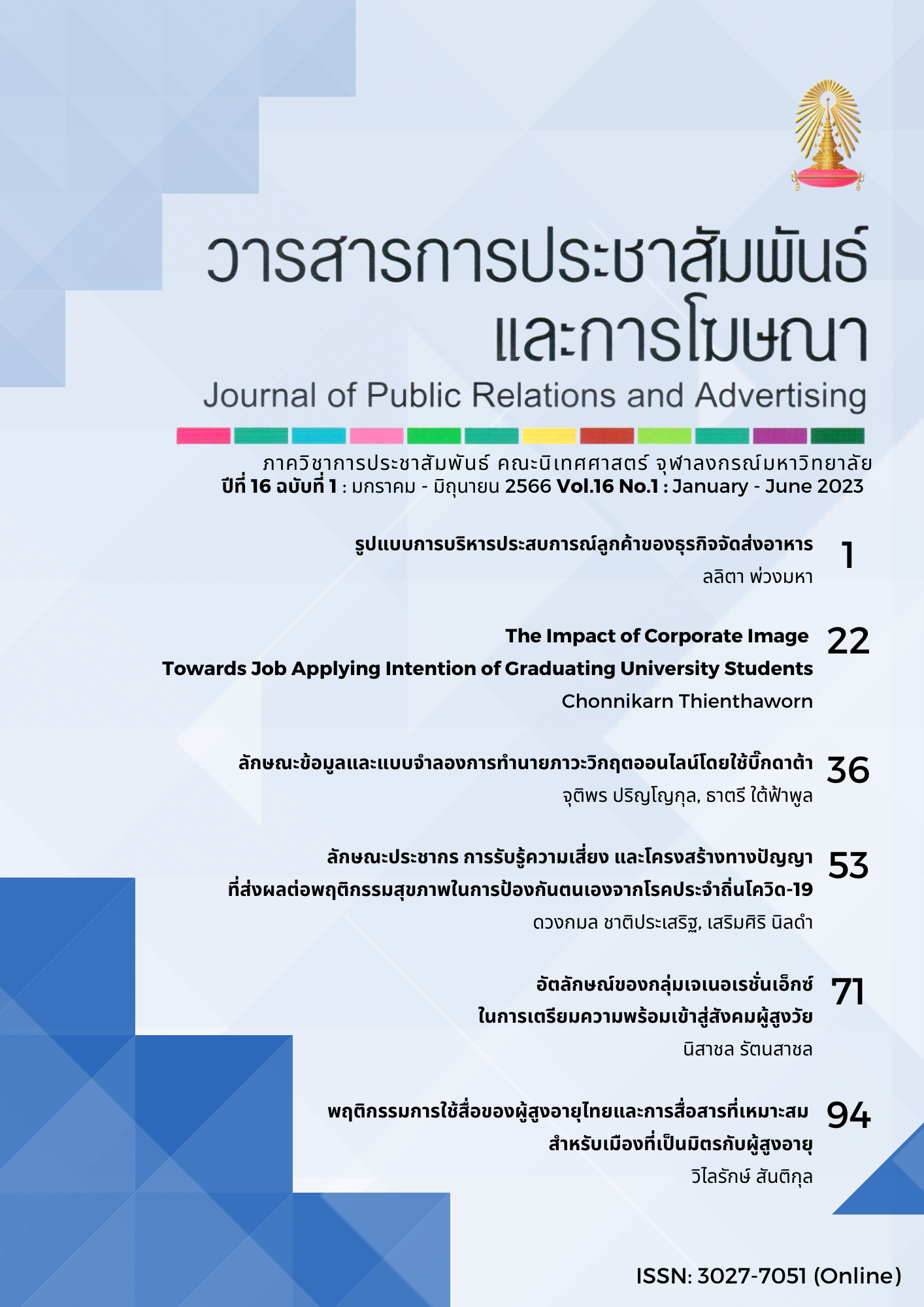Generation X’s Identity and Preparedness in Aging Society
Main Article Content
Abstract
The Super Aged Society has become and incessant problem in Thailand within 10 years. One-Fourth of population is “The Generation X” who born between 1965-1979 are thus around 43-57 years of age in 2022, will become the full agers within 2028. The uniqueness of GenX represent by the well-educated, the lifestyles which significantly different from the Baby Boomer’s, and this circumstance has attract the great attention to clarify the new concept of being ager. The research has the objectives of finding the identity, lifestyle and how GenX in Thailand communicate for the preparedness in aging society. The data was collected from GenX in total of 250 participants in Bangkok where can represent GenX’s identity. The factor analysis for personality and lifestyle were done through Activities, Interest and Opinion (AIOs) together with the attitude in the preparedness when they are all in agers period. The researcher also analyzed the preparedness in 3 main areas: economy, health and social life. The tools of factor analysis grouped the lifestyle segment of Gen X into 5 groups consisting of the Experiencer, the Family Centric, the Healthy, the Believer and the Achiever.
This paper also figured out that, demographically, when compared among age ranges, it was found that there was no difference in the preparedness in 3 aspects. On the contrary, when compared in lifestyles, the outcome was reflected in an astonishing way. Each group were focused in different of area as displayed by the Achiever who were most focused in economic, the Believer were most focused in health, and the Family Centric concentrated most in social area.
Article Details
References
กาญจนา แก้วเทพ. (2552-2555). การสื่อสารกับผู้สูงอายุ โครงการเมธีวิจัยอาวุโส “กระบวนทัศน์ใหม่ของการสื่อสารไทยศึกษา”. สำนักงานกองทุนสนับสนุนการวิจัย (สกว).
ศรีกัญญา มงคลศิริ. (2548). Power gens branding. พิฆเนศ พริ้นท์ติ้ง เซ็นเตอร์: กรุงเทพมหานคร
กำจร หลุยยะพงศ์. (2553). การสื่อสารกับวาทกรรมอัตลักษณ์ผู้สูงอายุในสังคมไทย. วิทยานิพนธ์ปริญญาดุษฏีบัณฑิต คณะนิเทศศาสตร์ จุฬาลงกรณ์มหาวิทยาลัย.
ชานนท์ ศิริธร. (2554). การเปิดรับสื่อและการยอมรับนวัตกรรมของผู้บริโภคเจเนอเรชั่นเอ็กซ์และเจเนอเรชั่นวาย. วิทยานิพนธ์ปริญญามหาบัณฑิต คณะนิเทศศาสตร์ จุฬาลงกรณ์มหาวิทยาลัย.
พัชนี เชยจรรยา. (2558). แบบจำลองเชิงโครงสร้างการยอมรับและรูปแบบการใช้ประโยชน์จาก เทคโนโลยีการสื่อสารของผู้สูงอายุ. สำนักงานคณะกรรมการวิจัยแห่งชาติ (วช.)
วรเวศม์ สุวรรณระดา. (2551). ระบบบำนาญแห่งชาติ. กรุงเทพฯ: โรงพิมพ์แห่งจุฬาลงกรณ์มหาวิทยาลัย
ธีระ สินเดชารักษ์ และพรทิพย์ เนติภารัตนกุล. (2554). ความพร้อมของแรงงานนอกระบบกับการเป็นสังคมสูงอายุในประเทศไทย., สำนักงานคณะกรรมการวิจัยแห่งชาติ (วช.).
Assael, H. (2004). Consumer behavior: A strategic approach. Boston, MA: Houghton Miffilin.
Schiffman, L.G. and Kanuk, L.L. (2010). Consumer Behavior. Prentice Hall, New York.
Shimp,T.A. (2007). Integrated marketing communications in advertising and promotion (7th ed.). China: Thomson South-Western.
Wells, W.D. and Tiger, D, J. (1971). Attitudes, Interests and Opinions. Journal of Advertising Research. 11, 27-35.


